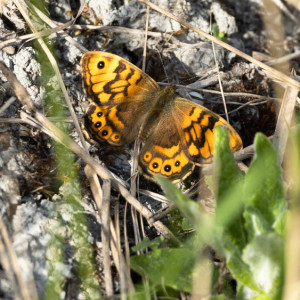Four-spotted
Today the weather was much brighter, with less of a breeze, and we ended up spending the whole day at the King's Dyke NR Bioblitz. Invertebrates were still decidedly sparse - I'm sure that the current dry spell hasn't helped. Significant areas that are normally damp were dry and cracked already. Nevertheless, we saw the first Cinnabar moths of the year, and there were several Wall butterflies in one area (see extra) who were quite reluctant to pose for a photograph.
The one shown is clearly freshly emerged and in beautiful conditions but decided to sit on a messy background! The Wall is aptly named after its habit of basking on walls, rocks, and stony places. The delicately patterned light brown undersides provide good camouflage against a stony or sandy surface. In hot weather, males patrol fast and low over the ground, seeking out females. In cooler weather, they will bask in sunny spots and fly up to intercept females, or to drive off other males.Over the last decade, it has declined substantially in many inland areas of central England and Northern Ireland. In our area it is now restricted to a few brownfield sites.
There were moderate numbers of Odonata around, mostly Azure, Variable and Blue-tailed Damselflies. The only dragonfly on the wing was Four-spotted hawker, which were mostly flying around at high speed, but which occasionally landed among the reeds. I like the face-on view of this one, with the soft colours of the reeds forming the backdrop.
At the end of the day I'd recorded 233 species of flowering plant, and several mosses, which was almost exactly the same number that I recorded in June 2021, although the actual species composition was different.


Comments
Sign in or get an account to comment.


